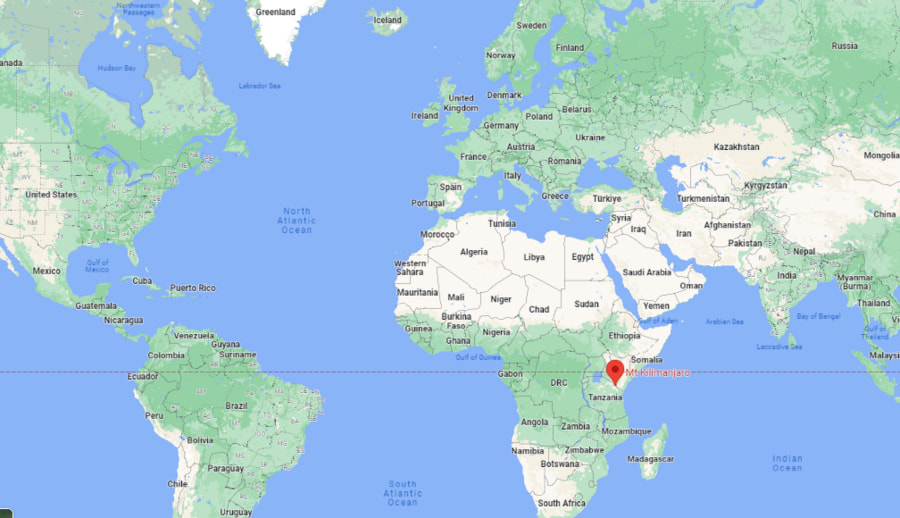Mount Kilimanjaro is located in Tanzania, near the border with Kenya. It is the highest mountain in Africa, at 5,895 meters (19,341 feet) above sea level.Kilimanjaro is a dormant volcano, made up of three volcanic cones: Kibo, Mawenzi, and Shira. Kibo is the highest of the three cones, and it is the summit of Kilimanjaro.
Location Map of Kilimanjaro, Tanzania
 About Map: Map showing Where is Kilimanjaro, Tanzania located in the Map.
About Map: Map showing Where is Kilimanjaro, Tanzania located in the Map.
About Kilimanjaro
Kilimanjaro is a majestic mountain located in Tanzania, East Africa. Here is some information about Kilimanjaro.Location: Kilimanjaro is situated in northeastern Tanzania, near the border with Kenya. It is part of Kilimanjaro National Park and lies within the Kilimanjaro Region. Physical Features: Kilimanjaro is a dormant stratovolcano, composed of three volcanic cones: Kibo, Mawenzi, and Shira. Kibo is the highest peak and is home to Uhuru Peak, the highest point on Kilimanjaro and the highest free-standing mountain in the world.
Elevation: The summit of Kilimanjaro, Uhuru Peak, stands at an impressive elevation of 5,895 meters (19,341 feet) above sea level. Climbing to the summit requires proper acclimatization and physical preparation. Climbing Routes: There are several climbing routes to the summit of Kilimanjaro, each varying in difficulty, length, and scenery. Popular routes include the Marangu, Machame, Lemosho, and Rongai routes. Each route offers a unique experience and different landscapes. Climate: Kilimanjaro's climate varies with altitude zones. The mountain has its own microclimates, including rainforests, heathlands, alpine deserts, and an Arctic-like summit. The lower slopes are generally warm and humid, while the summit experiences freezing temperatures and high winds.
Flora and Fauna: Kilimanjaro is known for its diverse ecosystems and unique flora and fauna. The lower slopes are covered in lush rainforests, home to a variety of plant species. As climbers ascend, the landscape transitions to heathlands, alpine meadows, and eventually rocky and icy terrain. Wildlife includes various bird species, monkeys, antelopes, and rare animals like the Kilimanjaro tree hyrax. Cultural Significance: Kilimanjaro holds cultural and spiritual significance for local tribes, including the Chagga people. It is considered a sacred mountain and features in their folklore and traditions. Tourism: Kilimanjaro attracts thousands of climbers and adventurers from around the world each year. Summiting Kilimanjaro is a significant accomplishment and a bucket-list experience for many. Guided treks and tours are available to support climbers in their ascent.
Climbing Kilimanjaro offers a unique blend of adventure, stunning landscapes, and cultural encounters. The mountain's prominence and allure make it an iconic destination for those seeking a memorable and challenging experience in the heart of East Africa.
World Travel Destinations
- 100 Wonders Of The World
- 7 Wonders Of World
- Where is Acropolis
- Where is Alhambra
- Where is Amalfi Coast
- Where is Amazon Rainforest
- Where is Angel Falls
- Where is Angkor Wat
- Where is Bali
- Where is Banaue Terraces
- Where is Bora Bora
- Where is Borobudur
- Where is Burj Khalifa
- Where is Cappadocia
- Where is Carlsbad Caverns
- Where is Chichen Itza
- Where is Colosseum Of Rome
- Where is Dubrovnik
- Where is Easter Island
- Where is Eiffel Tower
- Where is Fjords Of Norway
- Where is Galapagos Islands
- Where is Grand Canyon
- Where is Great Barrier Reef
- Where is Great Pyramid Of Giza
- Where is Great Wall Of China
- Where is Iguazu Falls
- Where is Konark Temple
- Where is Leaning Tower Pisa
- Where is Louvre Museum
- Where is Machu Picchu
- Where is Marrakesh
- Where is Matterhorn
- Where is Mecca
- Where is Mount Everest
- Where is Pagan Temples
- Where is Petra
- Where is Pompeii
- Where is Portofino
- Where is Potala Palace
- Where is Sahara Desert
- Where is Santorini
- Where is Sistine Chapel
- Where is Stonehenge
- Where is Suez Canel
- Where is Taj Mahal
- Where is Teotihuacan
- Where is Terracotta Warriors
- Where is Valley Of The Kings
- Where is Versailles
- Where is Victoria Falls
- Where is Mount Rushmore
- Where is Prague
- Where is Tunis
- Where is Curacao
- Where is Babylon
- Where is Death Valley
- Where is Tahiti
- Where is Oak Island
- Where is Mount Fuji
- Where is Timbuktu
- Where is Canary Islands
- Where is Monte Carlo
- Where is Atlantis
- Where is Dead Sea
- Where is Amalfi Coast
- Where is Kosovo
- Where is Great Barrier Reef
- Where is Panama Canal
- Where is The Red Sea
- Where is Aconcagua Mountain
- Where is Azores
- Where is Devil'S Tower
- Where is Antwerp
- Where is The Faroe Islands
- Where is Santorini
- Where is Kilimanjaro
- Where is Banff National Park
- Where is Mount Olympus
- Where is Ninevah
- Where is Mount Etna
- Where is Deadwood
- Where is Lake Titicaca
- Where is Yucatan Peninsula
- Where is Mount Mckinley
- Where is Angel Falls
- Where is The Blue Lagoon
- Where is Petrified Forest
- Where is Rock Of Gibraltar
- Where is Glass Beach
- Where is Atacama Desert
- Where is Mount Ararat
- Where is Falkland Islands
- Where is Channel Islands
- Where is Badlands National Park
- Where is Tree Of Life
- Where is Dubrovnik
- Where is Loch Ness
